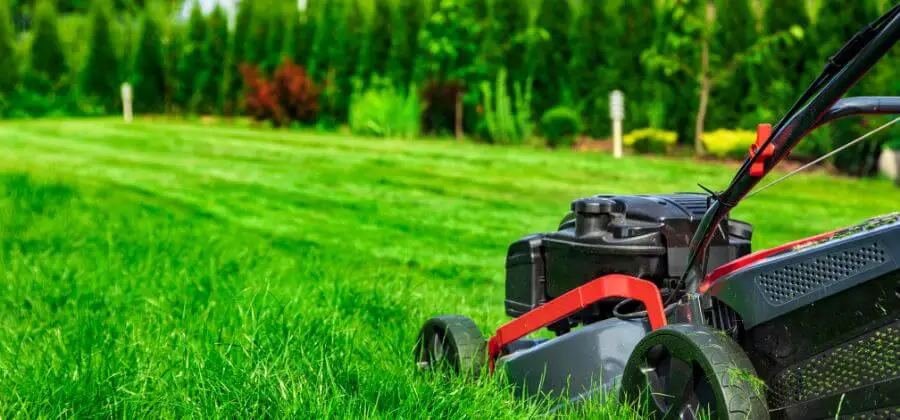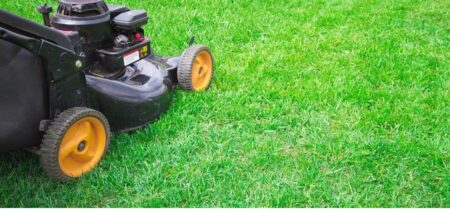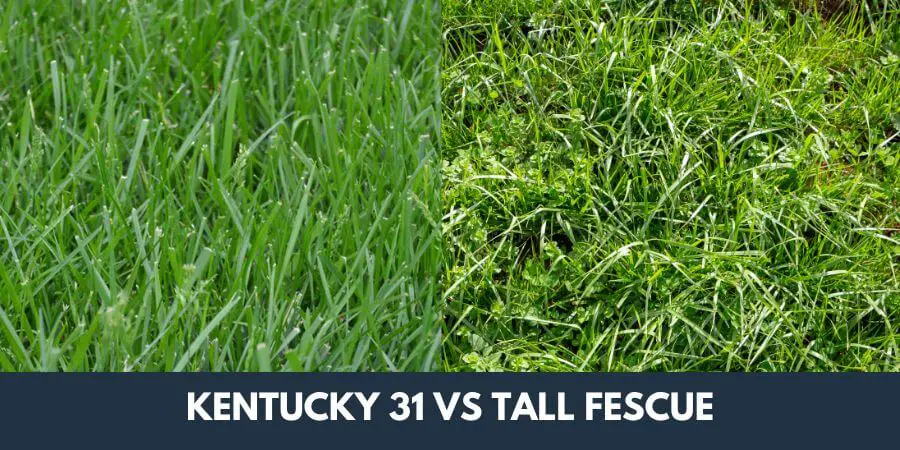In the spring and summer, you want lush, green grass. Who wouldn’t want to bury their toes in lush, carpet-like grass that felt soft to the touch? Not even thinking about it makes you feel less stressed. Working hard is necessary to achieve the lush, healthy lawn you desire. You must take care of your prized cut grass if you don’t want ugly brown stains or the consequences of heavy foot and animal activity.
Finally, you decided to get serious about your lawn care regimen this year. A thick, green, lush lawn is something to be proud of. But now that you’ve scheduled that fertilizer treatment, a question has cropped up: Should you mow before or after fertilizing? To keep your grass healthy, regular, appropriate fertilizer works to retain the soil’s nutrients at a constant level.
Alternatively, you could be unclear about whether to mow your grass before or after applying a treatment. Be at ease. We have your back. You can learn all there is to know about timing your mows around grass treatments here.
Mowing Before Applying Fertilizer: The Pros
Mowing before applying fertilizer has some benefits for your lawn.
First, it provides an even surface for the fertilizer to cling to. Long, uncut grass blades can prevent the fertilizer from reaching the soil, reducing its effectiveness. Mowing shortens the grass, so the fertilizer makes full contact with each blade.
It also allows for better coverage. When your grass is at an even height, the fertilizer disperses evenly across the lawn. Uneven-cut grass means the fertilizer concentrates more heavily in some spots, potentially burning certain areas.
Mowing ahead of time also reduces lawn damage. Taller grass is more prone to bending and breaking under the weight of the fertilizer particles. Shorter grass stands up better for the application process.
Finally, mowing before fertilizing saves time. You get two important lawn care tasks done at once, rather than doubling back to mow a few days after fertilizing. Your weekends will thank you!
While mowing first does provide some benefits, it ultimately comes down to your personal mow lawn care preferences and schedule. As long as you follow the directions on the product packaging regarding how soon before or after mowing you can apply it, you’ll be giving your lawn the nutrients it needs either way. The most important thing is keeping your grass at its ideal height and feeding it regularly. In the end, consistency and care are key.
Reasons to Mow After Fertilizing
The pros outweigh the cons here. Mowing after fertilizing your lawn allows the nutrients to get down into the grass plants, where they’re needed.
First, the fertilizer has time to dissolve and soak into the soil. Dry fertilizer granules and liquid sprays both need moisture to seep into the ground. Mowing too soon can disrupt this process and remove some of the fertilizer before it has a chance to work its magic.
Second, mowing stresses out your grass. Those sharp mower blades are damaging, even in the best conditions. Fertilizing first gives your mow lawn a boost to recover from the trimming. The fresh nutrients will help your grass bounce back and fill in any spots that were cut down.
Finally, mowing after fertilizing ensures even coverage. If you mow first, the fertilizer has to make its way through the remaining grass blades to reach the soil. Some areas may end up with more or less fertilizer, creating an uneven appearance. Applying the fertilizer first results in a uniform coat across your lawn.
While it can be tempting to mow and fertilize all at once to save time, your lawn will thank you for being patient. Mow a few days after fertilizing, once the product has dissolved and the grass has started to perk up. Your lawn will be lusher and healthier for it.
How Long Should You Wait Between Mowing and Fertilizing?
The best time is to wait at least 2 to 3 days after fertilizing before mowing the lawn. As a result, the fertilizer has plenty of time to thoroughly permeate the soil before the grass plants begin to absorb it. Mowing too soon after fertilizing can damage the grass blades and slow down nutrient uptake.
Give the Fertilizer Time to Work
Waiting a few days allows the fertilizer granules to dissolve into the soil, providing your lawn with the maximum benefit. The grass plants need time for their roots to absorb the nutrients. Mowing right after fertilizing may damage the grass blades, stress the lawn, and remove some of the fertilizer before it has a chance to be effective.
For the best results, check your specific fertilizer recommendations for re-mowing guidance. Most advise waiting 48 to 72 hours after fertilizing before mowing again.
Mowing Helps Fertilizer Absorption
Once enough time has passed, mowing your lawn helps with fertilizer absorption and distribution. The mowing action helps the fertilizer granules get worked down into the soil, bringing them into better contact with the roots. Mowing also stimulates new grass growth, enabling the plants to take up nutrients more readily.
The ideal approach is to fertilize and mow your lawn on a regular schedule, leaving 2 to 3 days between the two activities. Sticking to a routine helps ensure your lawn receives the right amount of nutrients to stay green and healthy all growing season. Mowing at the proper height and frequency, in combination with timely fertilizing, will give your lawn the ideal conditions to thrive.
Impact of Weather on Mowing and Fertilizing
Whether you should mow your lawn before or after fertilizing depends in part on the weather. Make the best decision for your grass by taking into account the existing and predicted weather conditions.
Temperature
If daytime high temperatures will be over 85 F in the week following fertilizer application, it’s best to mow first. Fertilizer can potentially burn grass blades during hot, sunny weather. Mowing before fertilizing will remove excess blade growth, allowing for better fertilizer absorption through the remaining blade surface area.
Rain
Rain or irrigation within 24–48 hours of fertilizing is ideal, as it helps move nutrients into the soil where the grassroots can access them. If significant rain is in the forecast soon after fertilizing, mowing first will allow the rain to better reach the soil. However, if no rain is expected after fertilizing and temperatures are moderate, mowing after fertilizing is fine and will not affect absorption.
Humidity
High humidity means grass blades will remain damp for longer periods, which can lead to disease development if mowing is delayed after fertilizing. Under humid conditions, mow before applying fertilizer to avoid disease risk. Lower humidity presents less risk, so mowing after fertilizing may be suitable if other factors like temperature and rain are also favorable.
In the end, you need to consider all the current weather factors together to determine if mowing before or after fertilizing is the best approach for your specific lawn conditions. When in doubt, mowing before fertilizing is the safer choice, especially for newly established lawns.
However, if your lawn is old and healthy, either schedule can be effective as long as you pay close attention to the forecast and your grass for any symptoms of stress or illness. Giving your grass the best start to the growing season is the most crucial thing.
Finding the Right Balance for Your Lawn
The type of grass you have and the season are only two of the variables that affect when it is best to mow and fertilize your lawn. Finding the ideal mix for your lawn’s demands is the most crucial step.
Mowing Before Fertilizing
Mowing a few days before fertilizing allows the grass blades to recover from being cut. This is especially important for taller-cut grass like fescue. Mowing first also allows for better absorption of the fertilizer since it can make direct contact with the grass stems and roots.
However, mowing too soon before fertilizing, around 1-3 days, may stimulate new growth that gets “burned” by the fertilizer. It’s best to mow 3 to 5 days before fertilizing to allow the lawn to recover while still benefiting from enhanced fertilizer uptake.
Mowing After Fertilizing
Mowing a few days after fertilizing, around 3 to 5 days, allows the fertilizer to start being absorbed before the grass is cut again. This helps the lawn make the most of the fertilizer you apply. Mowing after fertilizing also reduces the chance of fertilizer burn since the grass has had time to process the nutrients.
However, for some lawns, mowing after fertilizing may reduce fertilizer effectiveness slightly if the grass has grown too tall, as not all of the blades will absorb the fertilizer. Mowing taller grass after fertilizing can also lead to an uneven, patchy appearance.
The Balancing Act
As with many lawn care questions, the answer comes down to finding what works for your unique grass type and conditions. The ideal approach is often somewhere in the middle—mowing 2-3 days after fertilizing for most lawns. This provides the benefits of both mowing before and after, without the potential downsides. Paying close attention to your lawn’s needs and making minor adjustments will help you find the right balance.
Conclusion
The science says mowing after fertilizing is best for your lawn. However, you must ultimately choose an action that fits your needs and schedule. If it makes more sense for you, mow the lawn first to get it over with.
Don’t worry if you’re still not sure how to get ready for a lawn treatment. We are delighted to respond to your inquiries regarding the best period and cutting methods to assist you in taking good care of your lawn.
We are happy to share our knowledge of your preferences as a lawn care service.
FAQs
Do I need to mow the lawn first?
When to start mowing your lawn in the spring, according to experts As a general guideline, wait until the grass has started to grow actively and is at least 3 inches tall before you begin to mow it.
When is the ideal time of day to mow your lawn?
The majority of seasoned gardeners concur that the optimal time of day to trim your grass is between 8 and 10 in the morning.
What’s better, cutting quickly or slowly?
Some grass blades are left more intact than others when you mow your lawn too quickly since your lawnmower blades can’t cut every blade of grass. And to make matters worse, cutting the grass quickly may rip some of the blades.
Is cutting the lawn a good physical activity?
Mowing the grass has the potential to be a wonderful workout, just like a lot of other yard tasks.
For more lawn care tips visit here and for more guides related to mowers visit Mowers Guide








